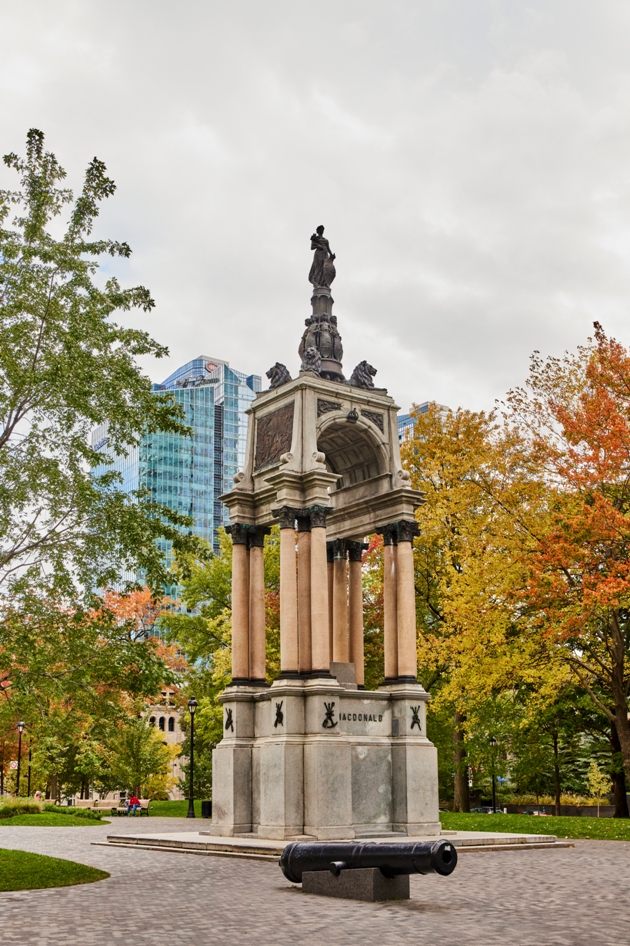George Edward Wade
Monument à sir John A. Macdonald
1895
Presentation of the artwork
On August 29, 2020, during a demonstration, the statue of John Alexander Macdonald was toppled. In the wake of this act, the Ville de Montréal decided to form an ad hoc committee to reflect on the future of the monument. In 2023, the committee recommended that the statue of Macdonald not be restored to its position. Steps to find a partner that will display the statue in a way that makes it publicly accessible are underway. A plan for restoration will be determined with that institution. Only the monument’s canopy and allegorical figures remain on the site.
In 1895, the site chosen for installation of the Monument to Sir John Alexander Macdonald was the south part of Dominion Square, positioning it as a focal point of a long perspective view. In 1967, this part of the square was renamed Place du Canada, a perfect fit with the presence of the monument, as Macdonald had been one of the first Fathers of Confederation (Dominion of Canada) and Canada’s first prime minister.
The canopy rests on an elevated pedestal, and its coffered vault is supported by 12 columns with Corinthian capitals, grouped in threes at each corner. At the top of the vault, a fluted column, tapered at the top, supports an allegorical figure, draped in Greek style and arranged as a crown, like a cathedral spire. The figure symbolizes Canada, and the seven boys with linked arms that hold each of the shields at the foot of the column represent the seven provinces. The grouping composed of the column, “Canada,” and the “seven provinces” sits on four elongated lions at each corner of the monument.
With its allegorical figures and decorative elements, the monument underlines the main events of Macdonald’s government, which contributed to the expansion of Canada. Among the monuments erected to the memory of Macdonald, the one in Montréal is the most imposing and elaborate.
Associated events
Sir John Alexander Macdonald, jurist, businessman, and politician, is widely recognized across Canada as one of the country’s “Fathers of Confederation.” Indeed, his central role in the plan to build the Dominion du Canada is indisputable: present during all the meetings and conferences aimed at discussing the terms of the union of the British colonies of North America and often leading the debates and negotiations, he was the main instigator of the writing of the British North America Act. In this regard, he was designated by the Governor General, Lord Monck, to act as prime minister of Canada – the first after Confederation – and then was elected in September 1867.
This interpretation of the figure and the heritage of John A. Macdonald is, however, far from consensual. The evolution of awareness and values among Canadians, the production of new studies on the historical period, and the recent discoveries of unidentified remains in proximity to former Indian residential schools have helped to uncover a darker side of Macdonald’s heritage: his policies promoting the assimilation and genocide of Indigenous peoples. As he held the positions of both prime minister of Canada and superintendent general of Indian affairs for a number of years, he is now recognized as the main architect of a carefully orchestrated plan with the stated goal of assimilating Indigenous peoples.
A member of the Orange Order and deemed anti-papist, anti-Catholic, and hostile to francophones, Macdonald is not enthusiastically celebrated by French Canadians. In addition, the repression of the Métis during the 1885 uprising, the hanging of Louis Riel, Macdonald’s efforts to deny the democratic rights of francophones in Manitoba, and his direct involvement in the Pacific Scandal provoked animosity toward him that have lasted to the present day.
In the light of these conclusions, Macdonald’s heritage is bitterly contested and the prestige that was once accorded to him has been broadly challenged.
George Edward Wade
Born in London in 1853, George Edward Wade began his professional career in the 1890s, when he began to have his works exhibited at the Royal Academy of Arts in London. His production consisted mainly of bust portraits, executed for commissions emanating from the British colonies. His services were retained by the city of Hamilton, Ontario, to create a statue of Macdonald in 1893. Although the statue was imposing in stature, no supplementary structure framed it. Wade died in London in 1933.
Presentation of the artwork
On August 29, 2020, during a demonstration, the statue of John Alexander Macdonald was toppled. In the wake of this act, the Ville de Montréal decided to form an ad hoc committee to reflect on the future of the monument. In 2023, the committee recommended that the statue of Macdonald not be restored to its position. Steps to find a partner that will display the statue in a way that makes it publicly accessible are underway. A plan for restoration will be determined with that institution. Only the monument’s canopy and allegorical figures remain on the site.
In 1895, the site chosen for installation of the Monument to Sir John Alexander Macdonald was the south part of Dominion Square, positioning it as a focal point of a long perspective view. In 1967, this part of the square was renamed Place du Canada, a perfect fit with the presence of the monument, as Macdonald had been one of the first Fathers of Confederation (Dominion of Canada) and Canada’s first prime minister.
The canopy rests on an elevated pedestal, and its coffered vault is supported by 12 columns with Corinthian capitals, grouped in threes at each corner. At the top of the vault, a fluted column, tapered at the top, supports an allegorical figure, draped in Greek style and arranged as a crown, like a cathedral spire. The figure symbolizes Canada, and the seven boys with linked arms that hold each of the shields at the foot of the column represent the seven provinces. The grouping composed of the column, “Canada,” and the “seven provinces” sits on four elongated lions at each corner of the monument.
With its allegorical figures and decorative elements, the monument underlines the main events of Macdonald’s government, which contributed to the expansion of Canada. Among the monuments erected to the memory of Macdonald, the one in Montréal is the most imposing and elaborate.
Associated events
Sir John Alexander Macdonald, jurist, businessman, and politician, is widely recognized across Canada as one of the country’s “Fathers of Confederation.” Indeed, his central role in the plan to build the Dominion du Canada is indisputable: present during all the meetings and conferences aimed at discussing the terms of the union of the British colonies of North America and often leading the debates and negotiations, he was the main instigator of the writing of the British North America Act. In this regard, he was designated by the Governor General, Lord Monck, to act as prime minister of Canada – the first after Confederation – and then was elected in September 1867.
This interpretation of the figure and the heritage of John A. Macdonald is, however, far from consensual. The evolution of awareness and values among Canadians, the production of new studies on the historical period, and the recent discoveries of unidentified remains in proximity to former Indian residential schools have helped to uncover a darker side of Macdonald’s heritage: his policies promoting the assimilation and genocide of Indigenous peoples. As he held the positions of both prime minister of Canada and superintendent general of Indian affairs for a number of years, he is now recognized as the main architect of a carefully orchestrated plan with the stated goal of assimilating Indigenous peoples.
A member of the Orange Order and deemed anti-papist, anti-Catholic, and hostile to francophones, Macdonald is not enthusiastically celebrated by French Canadians. In addition, the repression of the Métis during the 1885 uprising, the hanging of Louis Riel, Macdonald’s efforts to deny the democratic rights of francophones in Manitoba, and his direct involvement in the Pacific Scandal provoked animosity toward him that have lasted to the present day.
In the light of these conclusions, Macdonald’s heritage is bitterly contested and the prestige that was once accorded to him has been broadly challenged.
George Edward Wade
Born in London in 1853, George Edward Wade began his professional career in the 1890s, when he began to have his works exhibited at the Royal Academy of Arts in London. His production consisted mainly of bust portraits, executed for commissions emanating from the British colonies. His services were retained by the city of Hamilton, Ontario, to create a statue of Macdonald in 1893. Although the statue was imposing in stature, no supplementary structure framed it. Wade died in London in 1933.




